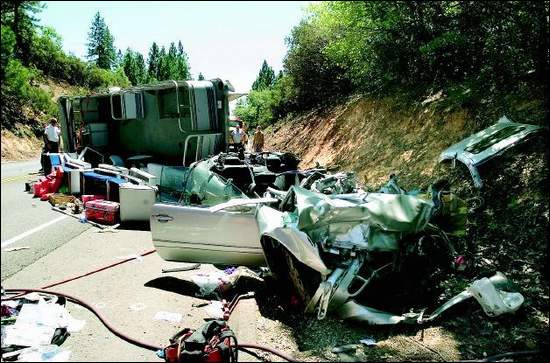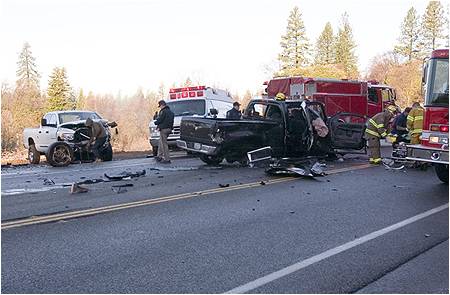Right call made to review fees, Union Editorial, January 26, 2006
Council ups money for parks, will study traffic, Trina Kleist, January 25, 2006
County road projects get boost, Dave Moller, January 25, 2006
Development fees tek, Trina Kleist, January 25, 2006
Construction update, Brittany Retherford, January 24, 2006
Another solution for 49: plastic reflective tubes, Tom Larson, January 21, 2006
Highway 49 pleas fall on deaf ears, Pat Butler, January 21, 2006
Lake of the Pines: Hwy. 49 a serious issue, Laura LaVelle, January 20, 2006
Center divider demanded, Robyn Moormeister, January 19, 2006
Crash heightens need for Hwy 49 safety measures, Robyn Moormeister, January 18, 2006
Photo gallery included
Rumble strip a Band-Aid for Highway 49, Union Editorial, January 17, 2006
Highway 49 debate smolders, Robyn Moormeister, January 17, 2006
Crash on Hwy. 49 turns fatal, Dave Moller, January 16, 2006
Governor offers nothing for our dangerous roads, Union Editorial, January 6, 2006
County is unlikely to see funds from highway bill, Robyn Moormeister, January 6, 2006
Right call made to review fees
January 26, 2006
The Grass Valley City Council took a prudent step Tuesday night when it
decided to postpone a vote that would have dramatically increased development
impact fees on new commercial buildings.
The proposal would have increased fees from $100,248.95 to $237,724.32, an
increase of 137 percent, for the new Moule Paint & Glass building on East
Main Street. Most of those higher fees - $210,978 - would have gone to either
local road projects or for regional traffic fees.
The building fees for a proposed 25,000-square-foot medical building would
have jumped from $127,823 to $425,573, or an increase of 233 percent. The
traffic and road fees would have increased from $85,974 to $375,491 in this
case.
The development impact fees for a new home, meanwhile, were scheduled to go
from $11,635 to $14,009, or an increase of 25 percent. Traffic and road fees
would increase from $1,086 to $4,219 in that scenario.
These proposals seem to spring from the premise that even longtime existing
businesses like Moule's are responsible for the increase in traffic in Grass
Valley. It does not seem to reflect the reality that many newcomers choose to
move here to take advantage of our remarkable quality of life.
The businesses and offices, therefore, are expanding or coming here to meet
the increased demand generated by growth. It's also in the interest of the
city to have local businesses that try to meet our growing needs or we will
see more people leaving the county to shop, which will cost local government
much-needed revenue to meet the costs that come with growth.
In the end, the community needs a more balanced development impact fee
schedule. Not only should those who choose to build new homes have to pay a
greater share of the costs associated with growth, but those who build the
largest homes should have to pay even a greater share.
It's unfair to ask small business owners to pay the lion's share of the cost
of growth. The higher fees could discourage them from expanding while at the
same time attract the chains that can afford the higher development costs,
which in the end might attract even more traffic to our streets.
In addition, it might be time for Grass Valley, Nevada City and Nevada County
to consider a more regional approach for development fees. An estimated 82
percent of Grass Valley's traffic is generated by nonresidents who travel here
to shop and enjoy our cultural amenities. As someone recently pointed out,
this area is like a large cul-de-sac at the end of Highway 49 and most of our
high-traffic arteries cross city and county boundaries.
Council ups money for parks, will study traffic
by Trina Kleist, trinak@theunion.com
January 25, 2006
The fees that Grass Valley charges to people building
a new building will go up, but not as much as had been projected by a draft
fee proposal.
After meeting for hours with business people, people concerned about traffic
and finance specialists, Grass Valley City Council members voted unanimously
late Tuesday to continue studying the fees they charge to pay for road
improvement and traffic impact.
The city's draft proposal for fee increases had some types of new buildings
paying increases of as much as 769 percent that would go toward local road
projects.
Instead, people will continue to meet through at least mid-June to work out
a more realistic fee structure.
"We're in agreement that the fees need to go up and that we're not
collecting enough," said Barbara Bashall, executive director of the
Nevada County Contractors' Association. She urged council members "to
do a traffic model and come up with a good basis for a traffic mitigation
fee program."
Part of the work will be to look at the road projects and traffic
mitigations that had been proposed originally, and weed out those projects
that either cannot be fully funded or which are lower in priority.
That would lead to a smaller fee increase than originally proposed.
City staff, fee specialists and members of the public also will continue to
work on fees for water, drainage and sewage, after another 5-0 vote Tuesday.
That work is expected to continue through at least the end of May, according
to the schedule worked out by city finance director Carol Fish.
In related matters, council members also approved higher fees to pay for the
increased burden on government facilities caused by growth.
However, at the suggestion of Councilman Mark Johnson, they also agreed to
remove from the fee calculations $1.2 million earmarked to expand City Hall.
The new construction is not included in the building plan, Johnson pointed
out.
That change will bring down another element in the overall fee structure.
In another vote, council members approved fee increases to acquire more park
land. However, Mayor Gerard Tassone said the city needs to find ways to
shift some costs of parks maintenance.
"The majority of impact (on parks) is coming from outside the city. The
city's picking up most of the tab," Tassone said. "How do you
establish the fair share?"
The fees are going up as a part of the city's effort to charge what it
really costs to improve and maintain roads, traffic conditions, parks,
public safety and infrastructure for buildings and city utilities.
Council had previously approved a new fee structure to pay for police, fire
and animal control services. They went into effect in December.
ooo
To contact staff writer Trina Kleist, e-mail trinak@theunion.com
or call 477-4231.
County road projects get boost
Dave Moller, davem@theunion.com
January 25, 2006
A revenue windfall and the New Year's storms have added $2.4 million in
projects to the county's road repair list.
"There was $1 million worth of damage we incurred over New Years,"
said county Sanitation and Transportation Director Michael Hill-Weld at
Tuesday's Board of Supervisors meeting.
Some of the money needed to repair the roads could eventually come back in
state disaster funding. But Hill-Weld said the county had to wait 18 months
for that money the last time there was flood damage and there is no guarantee
it will come this time.
To finance the expanded list of projects over the next three years, the county
will use more than $1.6 million in unexpected motor vehicle license fees and
other state funds. About $750,000 will come from current county road balances
of $12.7 million.
Among the road projects the board voted unanimously to add were the following:
• $900,000 for the re-pavement of Pleasant Valley Road from the rock quarry to French Corral and for Polaris Drive south of McCourtney Road.
• $500,000 to fix a pair of slip outs on Pleasant Valley Road between Penn Valley and North San Juan.
• $250,000 to replace a washed-out culvert on Stinson Drive in Alta Sierra.
• $150,000 apiece for reconstructing parts of Maybert Road in Washington and Donner Pass Road near Truckee.
• $60,000 venture with the city of Grass Valley to build a sidewalk leading to Mautino Park on Alta Street.
On the existing list to be completed are $1 million in safety improvements
on Wolf Road from Highway 49 to Duggans Road, about $900,000 for a curve
realignment on Dog Bar Road between Carrie Drive and Mt. Olive Road, and
another $400,000 in improvements to the Brunswick Road at Idaho Maryland Road
intersection.
Also on the existing list are:
• $600,000 in curve realignments on McCourtney Road at Elster Place and Adair Avenue.
• $400,000 in intersection improvements at Highway 174 and Brunswick Road.
• $400,000 for a center left turn lane on Rough and Ready Highway inside the town limits, plus shoulder and guardrail improvements.
• $240,000 for a right turn lane for Combie Road at Highway 49.
• $180,000 for a left turn lane for Brunswick Road at Town Talk Road.
ooo
To contact senior staff writer Dave Moller, e-mail davem@theunion.com
or call 477-4237.
by Trina Kleist, trinak@theunion.com
January 25, 2006
When Jim Moule built his paint and glass company on East Main Street in
Grass Valley 20 years ago, he paid $1,026 in fees to the city.
Last year, as he moved ahead on plans to build his new facility up the street,
he planned to pay more than $100,000 in development impact fees.
Those fees are still going up - but not as much as had been anticipated.
Late Tuesday, Grass Valley City Council members unanimously approved fees for
parks and for general government facilities.
But they also voted to spend more time studying the source of the largest
increases: fees for local road projects and traffic impact.
Before that vote, all of the proposed new fees together would have cost Moule
$238,000.
Moule's first building "didn't cost me $238,000 for the entire project
and now the fees are that much," he said. His biggest worry is whether
his bank would loan him the money to cover the 137 percent increase.
"For someone who's a small businessman looking to expand, it puts you out
of reach of the financing," Moule said. "That extra $100,000 would
probably be a project-killer because I'm already at the max" of his
credit.
But the traffic portion of the fee is now likely to come down. In the next six
months, the city will work with business people and those concerned about
traffic to pick only the most important projects and the ones that have the
best chance of getting completed.
All together, the fees pay for improvements to roads, water and sewage
facilities, parks, fire and police protection, and government facilities that
are affected by growth.
City officials have said the fees have not kept pace with the city's growth.
They are needed to pay for new signals and deteriorating roads.
But some business people bristle about the way the money has been spent. Moule
already has seen the road fee for his project rise from $14,000 to $40,000.
The draft plan to increase the road fee again would have pushed his fee to
$146,000. With Tuesday's vote, however, the increase is expected to be
smaller.
"They've been collecting money for 20 years and we haven't seen where
it's going," Moule said. "I don't mind paying some road mitigation
fees, but I don't want to pay $40,000 that's going into the pocket of some
consultant."
City finance planners and a Maryland-based consultant, TischlerBise, looked at
how the draft proposed fee structure would raise costs for certain projects,
including Moule's.
According to the calculations, the fees affect different projects in different
ways. The biggest areas of increase for all of them is in the cost for local
road projects and fees charged based on the number of driving trips a business
is expected to generate.
Originally, the draft fee structure proposed raising the bill for road
improvements by as much as 769 percent for some projects.
A proposed medical office building could have seen the road fee rise from
nearly $30,000 to nearly $260,000.
The road fee for a proposed single-family home would have risen from $336
to nearly $3,000.
If Matthew Weaver had had to pay fees at that level when his project to expand
Weaver Auto & Truck Center went through more than a year ago, he may not
have been able to swing it, he said.
He already has paid close to $200,000 in fees for that project, which is
similar in size to Moule's, Weaver said.
"I have to take out a loan to do my work," said Weaver, who is
co-owner and chief financial officer of the East Main dealership.
"There's a limit to what the bank will do."
ooo
To contact staff writer Trina Kleist, e-mail trinak@theunion.com
or call 477-4231.
By Brittany Retherford
January 24, 2006
Nevada City's pocketed streets are slated to be smoothed over this summer
says Bill Falconi, the town's engineer.
Several roads are on the list, but those considered a top priority are Boulder
and Adams streets. Others include Clay Street, Nevada Street, upper Coyote
Street and Main Street, among others.
The city has been waiting to gather its resources before launching the paving
project, which Falconi estimates will last about six weeks. A project such as
Boulder Street would take about seven days, he said. It is estimated that it
would cost the city between $60,000 and $75,000.
The city now has about $200,000 in its coffers for road repairs, but Falconi
said he is anticipating an additional $200,000 to $300,000 from state
reimbursements for the gas tax and sales tax. The city has also applied for a
grant to help offset the cost of installing a recycled material - rubberized
asphalt - rather than the traditional mix.
The recycled material does cost more, but might also last longer and is made
from recycled tires, Falconi said.
The city road project would likely occur between June and August,
weather-depending.
- Brittany Retherford
Another solution for 49: plastic reflective tubes
January 21, 2006
There is no doubt that preventing head-on collisions is the primary aim of
any consideration for Highway 49. I think there is another interim choice that
I have not seen put forth that is more effective than a rumble strip and less
costly than a concrete barrier or widening the road.
Recently, where Idaho-Maryland crosses Brunswick, plastic reflective tubes
were glued to the pavement to delineate the new island. I propose that these
reflective tubes be placed along Highway 49 at 5-foot intervals, which would
act as a visual deterrent and physical barrier. Most people, when confronted
with very narrow lanes, as in toll plazas, pay considerably more attention to
their driving. These tubes pose no barriers to wildlife, so when an animal
attempts to cross the road, oncoming traffic will see it early and be able to
react accordingly.
Best of all, these tubes will be highly visible. At 42-inches tall, with two
3-inch-reflective stripes at their tops, whether the road is wet, snowy, or
covered with ice, both sides of traffic will always know where the center line
is and that the hazard is there.
And, Caltrans can afford it. This prospective solution Š 10 miles of tubes,
spaced at 5 feet, costs only $194,832 at retail at TrafficSafetyStore.com.
That leaves Caltrans with $200,000 for installation ($15 per tube should cover
it) and another $100,000 for replacement of damaged tubes over time.
No solution is perfect. It would seem that traffic tubes are far superior to
rumble strips as acting as a visual and physical deterrent in all types of
weather, day or night. Widening and concrete barriers may eventually be the
best solution, but immediate action with funds available will save more lives
than haggling over long-term solutions. Solutions that create more attentive
driving, provide an increased level of protection, are doable and affordable
and should be implemented. Maybe we will find that this solution was all that
was needed.
ooo
Tom Larsen lives in Grass Valley.
Why plastic tubes won't work
Editor's note: This is a response from Tom Wood, the deputy district
director for Caltrans District 3, to the idea of using plastic reflectors on
Highway 49.
The suggestion you forwarded certainly has merit. Unfortunately, in the
mountains, where snow and snow removal is required (even if intermittently
year to year) the use of raised markers is not practical for long stretches of
roadway. For this reason, where we use reflective markers on roadways above
the "snow line" they are recessed (Route 174, Highway 20 above
Nevada City, Highway 20 Grass Valley to Penn Valley are example locations with
recessed markers).
The other major consideration about raised markers is the effort required to
maintain them, which is a cost and safety concern for our maintenance staff.
However, as we design the rumble strip project and continue to study the most
effective measures to improve safety on Highway 49, we may consider adding
some reflective tubes below Lime Kiln Road that could be placed in the center
of the rumble strip. Improving delineation of the highway is a major objective
of our effort and as I showed in the picture at the meeting the rumble strip
with recessed reflective markers should provide significantly enhanced
delineation over the existing condition.
Pat Butler: Highway 49 pleas fall on deaf ears
By Pat Butler
Editor, patb@theunion.com
January 21, 2006
Firefighters had to cut the roof off a Mercedes driven by 67-year-old Josephine Sarrugia on
Aug. 13, 2004, when a truck hauling a pontoon boat collided with Sarrugia's coupe on Highway 49.
Sarrugia was among those who testified at Wednesday night's hearing.
The Union photo/John Hart
One by one they stepped up to the microphone and made their plea for
concrete barriers on Highway 49.
They are the survivors of terrible collisions or they spoke on behalf of their
loved ones who died in head-on crashes on that increasingly dangerous stretch
of highway that connects Grass Valley and Auburn.
Some cried while testifying and others reached out for hugs after sharing
their stories of a husband, wife or child who died suddenly and violently
while driving down that road.
In the end, however, their testimony isn't going to make any difference except
perhaps for the warm feelings of acknowledgement they experienced when
listening to the applause from among the 300 or so people who attended the
session Wednesday night at Bear River High School.
Tom Wood of Caltrans said Thursday that the decision was made before the
meeting to spend $500,000 on a rumble strip that even he acknowledged at the
meeting wouldn't prevent head-on crashes. So much for the perceived value of
public testimony.
It's important to point out that Caltrans representatives told reporter Robyn
Moormeister in December that no money was available for any new safety
improvements on Highway 49. It was only after Assemblyman Rick Keene and then
Supervisor Sue Horne got involved that $500,000 was found for a safety
project.
So from the start of these discussions, Caltrans District 3 officials have not
made Highway 49 a top priority.
So now we know that it really wasn't a public hearing, but a public
presentation made by bureaucrats who rely on statistics, which can be
misleading.
Wood said Thursday that statistically Highway 49 is not that deadly. That's
because the increase in daily trips - now at 28,000 - keeps our death rate
down. Never mind that the increase in traffic likely plays a role in the
increase in deaths there.
Wood has other reasons that he cites when making the case against concrete
barriers. He points to the many driveways along Highway 49 and expects that
the property owners would start howling if they can't take a left turn from
their property.
Personally, I've always thought that taking a left turn on 49 is like playing
Russian Roulette. Besides, I already know plenty of people who say it is often
too risky to make a left turn onto 49. I'm also wondering why the expected
complaints of homeowners takes precedence over the concerns of the thousands
of people who use that road each day.
He also said concrete barriers can be the source of crashes, even displaying
on Wednesday night a car that smashed head-on into one of them. He did add,
however, that crash cushions would mitigate that problem. I believe it is
better for speeders and reckless drivers to either sideswipe or hit a concrete
barrier than to hit another vehicle head-on and kill or maim an innocent
victim. But evidently personal accountability is not an issue here.
Wood also mentioned the problem that barriers can cause for animals that cross
the highway, which are probably the same animals that are now striking cars
and motorcycles.
The bottom line, however, is the cost, according to Wood. Before concrete
barriers can be added, he said, the road has to be widened by at least 13 feet
and before that can be done Caltrans needs to do environmental and other
studies. In the end, he estimates it would cost $1 million a mile to add
concrete barriers.
Case closed in a state that's unable to sustain its highway system and for a
rural area that doesn't have much clout in Sacramento.
Perhaps, the only bright spot in the evening came from California Highway
Patrol officers who pledged to continue writing tickets at a furious rate. The
problem is that only three officers patrol that road, which means they too are
short-handed.
So, what exactly is Caltrans going to do for us and will it make any
difference?
First, there's a Phase One that will absolutely have no influence on drunken,
drugged, aggressive, lousy or reckless drivers. It includes initiating a
Safety Task Force, disseminating public safety messages through the media and
on posters, supporting CHP enforcement efforts and adding speed limit and
warning signs to the highway.
Phase Two is the installation of the $500,000 rumble strip, which is
expected to happen this summer or fall. The purpose of the strip, according to
Caltrans literature, is to "improve daytime and nighttime delineation,
alert drifting drivers, discourage illegal passing maneuvers and improve
motorist awareness."
This phase also includes the elimination of short passing zones at two
locations.
Finally, there's Phase Three and that's where we see the first mention of a
concrete barrier and the widening of the highway to five lanes. It was made
pretty clear on Wednesday night and again Thursday that these projects are not
just around the corner or probably even at the end of the rainbow.
I guess in the end Highway 49 will have better striping and your vehicle will
shake quite a bit if it passes over the rumble strip. But none of that will
make any difference if the last thing you ever see is another vehicle crossing
the center line at 65 miles per hour.
Pat Butler is the editor of The Union. He can be reached by e-mail at patb@theunion.com
or by phone at 477-4235.
Lake of the Pines: Hwy. 49 a serious issue in this county
By Laura LaVelle
January 20, 2006
The weekend has arrived. Maybe you are planning to partake in the pancake
breakfast Sunday at the Lake of the Pines clubhouse or, finally, enjoy real
snow in the Sierra. Entertainment opportunities await residents both north and
south on Highway 49.
We live in a fantastic area, full of beauty and recreation, but it would be
impossible to enjoy any of it if you were severely injured or killed on
Highway 49. Did you ever consider that you or a family member might be the
next victim of that treacherous strip of asphalt?
For many, that fear is a reality. We have all seen the markers friends and
family members have erected at the crash sites. To those surviving victims and
family members, transforming this stretch of highway has become a priority -
every trip to Auburn or Grass Valley a burning reminder of the road's danger.
A group of approximately 300 concerned citizens, and public officials gathered
Wednesday evening at the Bear River High School multipurpose room to discuss
ways to make this strip of highway more safe. Bruce and Deborah Jones, who
suffered a Highway 49 head-on collision two years ago, organized the meeting.
Presentations on the topic were made by Tom Wood, Deputy District 3 Director
of Caltrans; Sergeant Whitmore of the Grass Valley California Highway Patrol;
and Dan Landon of the Nevada County Transportation Commission.
Wood outlined three phases of action to battle obstacles to a safe Highway 49.
Among the proposals were soft barrier median strips to be installed in the
summer/fall of 2006, enhanced patrols in the area with a zero-tolerance policy
for drivers not obeying the speed limit or driving with their lights on, and,
finally, widening 49 from Combie Road to the McKnight exit. Wood estimated the
cost for that project might be as much as $80 million and no funding has been
secured. Wood also stated the road was not wide enough for concrete barriers,
and they would create problems due to the more than 100 driveways on 49 from
Combie Road to McKnight.
Wood made what I believed to be a major faux pas. Early in his presentation,
he cited the fact that Highway 49's accident rate was actually below a
statewide average-a rather insensitive statement to those in the audience
whose loved ones were killed. One or more citizens later challenged him on
that statistic during the question and answer period after the presentations.
The point was made that of the accidents that did occur, many were fatal
head-on collisions.
The most interesting segment of the evening was when residents and victims
used the microphone to give compelling testimony regarding their concerns
about the highway. Some advocated widening 49 to five lanes, while many made
the case for the concrete barriers, believing that those alone would have
prevented the fatalities.
A particularly moving statement was given by Don Cheeseman, a former resident
of Lake of the Pines whose 31 year-old wife Debbie and 1 1/2 year-old daughter
Karen were killed on Highway 49 more than 15 years ago.
After Cheeseman spoke, a friend seated in the audience held up a portrait of
his baby girl, sending a wave of compassion through the room. Four years
later, Cheeseman himself avoided a head-on collision on 49 and ended up in a
ditch. He had also been a member of an action committee during that time
period and was instrumental in improving the highway somewhat but not enough.
He expressed a wish that this time the effort would succeed in transforming
49.
Near the end of the meeting, Tom Wood of Caltrans again seemed to defend the
highway's status quo by arguing against reducing the speed limit saying that a
lower speed would create a "speed trap," thereby opening the
government up to lawsuits. I am sure those in attendance would gladly trade
the Highway 49 "death trap" for a speed trap any time.
The meeting came to an abrupt end when the lights flickered then went out,
ironically due to a power line being struck by a motorist on Magnolia Road.
I left the meeting with mixed feelings of hope and frustration, knowing that
we have a dangerous road and no funding to widen it. I have no doubt the
people in attendance will slow down and take extra precaution when driving on
49, but those who don't will continue to add havoc to the already dangerous
roadway.
My hope is that we will all be here to enjoy a pancake breakfast at the LOP
clubhouse on Sunday, to graduate from high school, to see our grandchildren
and to live our lives free of highway tragedy. Take time to drive safely on
49, obey the traffic laws slow down, and contact Citizens for Highway 49
Safety at 268-2370 to join in the effort to transform our road.
Laura Lavelle is a resident of Lake of the Pines, and her column is for
Lake of the Pines area residents to share thoughts and information. Contact
her at laural@theunion.com
or leave a phone message with the readership editor at 477-4238.
Residents sound off at Highway 49 meeting
By Robyn Moormeister
Staff writer, robynm@theunion.com
January 19, 2006
Fed up with fatal accidents and desperate for immediate solutions, local
residents made it clear they want center dividers installed on Highway 49
between Grass Valley and Auburn at Wednesday night's community meeting.
Dozens of Alta Sierra and Lake of the Pines residents took turns at the
microphone at the Bear River High School multipurpose room, arguing their points
to Caltrans representatives, who say there are currently no plans to install
center barriers.
Many of the residents were accident victims, family members of people killed in
head-on collisions and mothers with high-school aged children who battle with
traffic on the highway every day.
Shirley Thomas of Alta Sierra tearfully explained to the crowd of approximately
300 what is was like to spend her 36th wedding anniversary without her husband.
He was killed last April in a head-on crash on Highway 49, when a driver swerved
to miss some deer and hit the truck in which he was a passenger. Their
anniversary was shortly after his death.
"I sat alone and cried," she said.
Thomas said a center barrier probably would have prevented her husband's death
and the latest $500,000 project proposed by Caltrans -- a continuous rumble
strip, reflectors and improved signage -- will not prevent such severe
collisions.
"I don't think a rumble strip will stop this kind of head-on," she
said. "We need more than a rumble strip and we need it soon."
Svend Nance lost his sister-in-law, Julie Trathen, to another fatal crash on
Dec. 19, 2005, when Christopher Leighton, 18, of Auburn drove his car across the
double yellow lines to pass two vehicles and struck her truck head-on. Leighton
also died in the crash.
"I can't help but think a center barrier would solve the problem,"
said Nance, a retired firefighter for the Sacramento Metro Fire Department.
"They would keep vehicles from crossing the road."
Tom Wood, Deputy District 3 Director of Caltrans told the crowd that the road is
too narrow for center dividers and that rumble strips and reflectors will
improve motorist awareness and discourage illegal passing for now.
Eventually, Caltrans would like to widen the highway to five lanes, but there
is currently no funding available for that kind of extensive project, he said.
Other members of the audience encouraged the crowd to write to their state
representatives to plead for a share of state funds available for transportation
safety improvements, money currently earmarked for urban areas under Gov. Arnold
Schwarzenegger's strategic growth plan.
Addresses for state representatives such as Assemblyman Rick Keene (R-Chico) and
Senator Sam Aanestad (R-Grass Valley) will be listed on the Nevada County
Transportation Commission's Web site, www.nctc.ca.gov
starting this morning, said Dan Landon, the commission's executive director.
"Send in your letters," Landon said. "We need to make the
governor's program a statewide program that will include rural areas."
Crash heightens need for Hwy 49 safety measures
- Photo gallery includedBy Robyn Moormeister
Staff writer , robynm@theunion.com
January 18, 2006
Sunday's fatal crash will provide new urgency to the scheduled Highway 49
safety meeting tonight.
June Worth, 57, died from injuries she sustained Sunday morning on an icy
Highway 49, when her friend, Dennis Burkett, of Grass Valley, reportedly drove
his Dodge Ram truck across the double yellow lines near McKnight Way and
collided head-on with another Dodge Ram truck.
According to the California Highway Patrol, Worth was riding in the front seat
between Burkett and his 11-year-old daughter Katherine, who was riding in the
passenger’s seat.
Burkett was reported to be in fair condition Tuesday at Sutter Roseville
Medical Center and his daughter, recovering from moderate injuries, was listed
in good condition at UC Davis Medical Center in Sacramento.
The driver of the other truck, 42-year-old Gary Van Winkle of Grass Valley,
sustained an abrasion on his forehead.
Worth was airlifted to Sutter Roseville Medical Center with major head and
chest trauma, where she was later pronounced dead.
The CHP will recommend that Burkett be charged with involuntary manslaughter,
said investigating officer Eric Wagner. He said Burkett was driving faster
than was safe for the icy conditions that morning.
Worth had recently moved from Grass Valley to Auburn, said CHP Sgt. Dee
Lavrador.
At the time of her death, Worth was married to Gary Worth of Alta Sierra, said
CHP Officer Jeff Pingree. He was the first person notified of Worth’s death,
he said.
Worth’s son traveled from his home in San Carlos after the accident and was
staying with family Tuesday in Grass Valley, Pingree said. Worth reportedly
has more family members in San Carlos.
Sunday’s fatal accident may be a topic of discussion at tonight’s public
meeting that will address the recent rash of deadly head-on collisions on
Highway 49. The meeting was organized by Grass Valley residents Bruce and
Deborah Jones, survivors of a serious head-on crash on Highway 49 in Dec.
2003.
Representatives from Caltrans, CHP, local and state governments will attend.
The meeting is at 7 p.m. in the multipurpose room of Bear River High School,
11130 Magnolia Road, Grass Valley.
To contact staff writer Robyn Moormeister, e-mail robynm@theunion.com
or call 477-4236.
The photos below were taken by The Union photographer John Hart at several of the severe accidents on SR 49 during 2005.
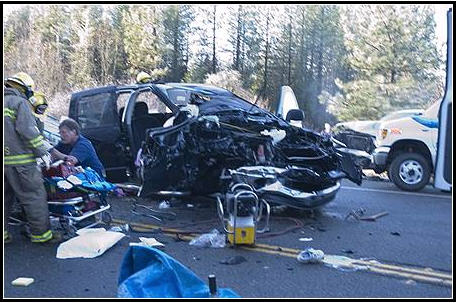
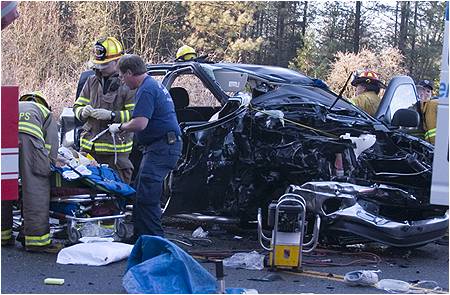

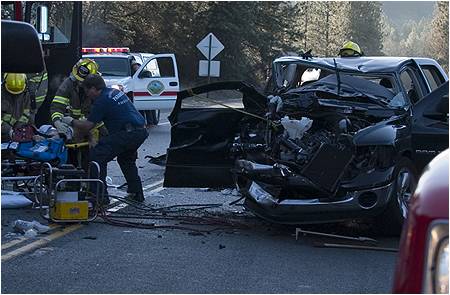
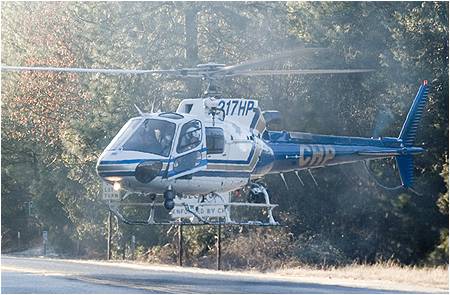
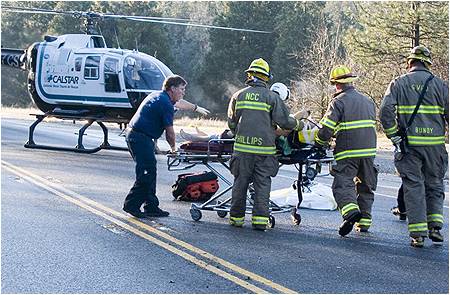
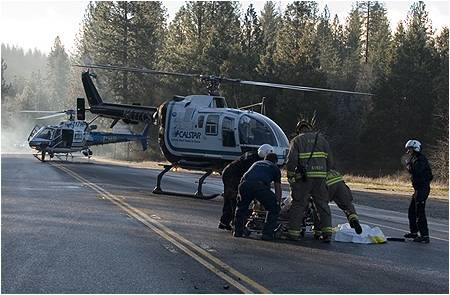
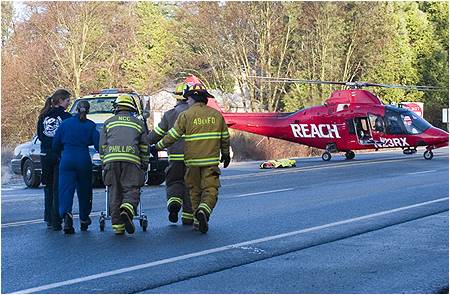
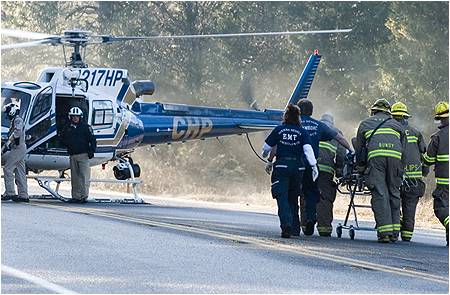
Our View: Rumble strip a Band-Aid for Highway 49
By The Union Editorial Board
January 17, 2006
It is encouraging to learn that the California Department of Transportation
has been able to secure $500,000 for Highway 49 from the State Highway
Operation and Protection Program.
The announcement comes just days after Assemblyman Rick Keene said he would
work to find money for Highway 49. Nevada County Supervisor Sue Horne has also
lent her support to efforts to find money for this project.
Now, we need to make sure the money is spent in the best possible way.
As if we even needed another reminder about the dangers of this highway,
another fatal accident occurred this weekend. It marks the 12th time in 13
months that someone has died on the stretch between Grass Valley and Auburn.
Investigators are citing a combination of speed and icy road conditions for
the latest head-on accident, which occurred when a truck crossed the center
line and crashed into another pickup truck.
On Wednesday night, Caltrans officials are expected to propose ways to improve
safety on Highway 49. At this point, the apparent centerpiece of their plan is
the installation of a rumble strip that would warn drivers when they stray
across the center line.
A rumble strip, however, would not have prevented at least seven of the 12
deaths that happened in the past year. Those fatalities all resulted from a
vehicle crossing the center line and crashing into an oncoming vehicle, the
type of accident that is usually unavoidable for those in the other lane.
In all likelihood, concrete barriers would have prevented those accidents.
Caltrans, however, has stated that concrete barriers would make it difficult
for emergency vehicles to respond to crashes. At the same time, it seems that
concrete barriers might reduce the need for emergency vehicles in the first
place.
Caltrans officials need to study all options before they commit to spending
$500,000 for this much-needed safety project. Included in that process should
be an examination of the effectiveness of concrete barriers, the cost of
installing them and the potential problems of using them.
Rumble strips seem to be more of cosmetic approach that will provide the
impression that something is being done without really protecting law-abiding
citizens from reckless and speeding drivers.
In the meantime, we need more traffic enforcement on the road and for
officials to consider reducing the speed limit.
Wednesday's meeting starts at 7 p.m. and will be held at the Bear River High
School Multipurpose Room. In addition to Caltrans officials, a number of
government officials and representatives from law enforcement are expected at
the meeting.
It will be an important opportunity to share your thoughts on this matter.
Appropriately enough, you will likely have to take Highway 49 to get there.
As you travel down that road and look into the long line of traffic that is
passing within inches of your vehicle, think about whether a it's rumble strip
or a concrete barrier that will make you feel more secure.
By Robyn Moormeister, robynm@theunion.com
January 17, 2006
The two-lane drive on Highway 49 between Grass Valley and Auburn that has
turned deadly with population growth will be the topic of a public discussion
Wednesday, as local residents and safety officials demand immediate
improvements.
Eleven people died in head-on collisions on that stretch in 2005, up from two
deaths in 2004; now a 57-year-old Auburn woman is the latest victim of the
dangerous drive, the first fatality of 2006.
"I was holding my breath hoping that maybe nothing would happen before we
had a chance to do something about (Highway 49 safety)," said Bruce
Jones. Jones and his wife, Deborah, involved in a head-on collision on Highway
49 in Dec. 2003, have led the charge to improve safety on the highway and
organized Wednesday's meeting.
"I didn't expect another death so soon," Jones said.
Cement barriers between opposing lanes - an improvement the Jones' condone -
would probably have prevented the latest death, said California Highway Patrol
Officer Eric Wagner.
"Absolutely," Wagner said. "Head-on collisions are more severe
than non-head-ons."
But representatives of Caltrans, which is expected to have officials in
attendance Wednesday, say cement barriers are not the answer because they will
impede emergency vehicles such as ambulances and fire trucks.
"The reason we shy away from cement barriers is the emergency crews can't
get around them," said Caltrans public information officer Jan Mendoza.
Instead, Caltrans officials announced Friday they are planning the installment
of a centerline rumblestrip the entire length of the roadway and wider double
yellow lines between the Wolf and Combie roads intersection on Highway 49 and
McKnight Way, along with added speed limit signs, warning signs and reflectors
- all of which comprise a $500,000 project.
"I'm very pleased that they plan on doing that work," said Nevada
County District 2 Supervisor Sue Horne, who said she has driven that stretch
of Highway 49 for 25 years.
Horne said at first glance K-rails (cement barriers) seemed like a good idea
but after talking to the CHP and hearing their concerns, she changed her mind.
"It does delay emergency response time," she said. "What if an
emergency vehicle had to pull a quick (U-turn) and there's a K-rail there?
That's a problem."
A Caltrans-sponsored driver education program may also reduce the amount of
head-on collisions, Horne said.
"Most of these accidents were due to driver error," she said.
"There is a need for an educational component."
Ultimately, Horne said, widening the highway along the entire 12-mile stretch
would be the best solution, but it's a project of massive proportions that
Caltrans officials say the state presently can't afford.
"Ultimately the issue is capacity," said Caltrans representative
Shelly Chernicki. "Traffic volume is up and adding capacity alleviates
the safety issues."
She estimated widening would cost the state $222 million.
"I think for the short term," Horne said, "(the rumble strips
are) certainly a very good start."
Horne and Nevada County Transportation Commission Executive Director Dan
Landon say they will continue lobbying state officials for funding to widen
Highway 49.
"The governor's strategic growth plan addresses congestion in urban
areas," Landon said. "While urban congestion is a large problem,
it's important to look at the needs of rural areas."
He said he will encourage California Assemblyman Rick Keene (R-Chico) to seek
out funding for highway widening.
Horne said local officials have been trying to gain attention and funding from
the state even before the last year's rash of deadly head-on collisions.
"We have been (lobbying) for years," she said. "The Board and
the Transportation Commission have all been talking with legislators on the
state and federal level. They're well aware of the need for
improvements."
Horne said she and fellow Supervisor John Spencer will meet privately today
with representatives from Caltrans, the CHP and the offices of Keene and Sen.
Sam Aanestad (R-Grass Valley) to prepare for the public meeting.
The same representatives from each organization will also attend the public
meeting at 7 p.m. Wednesday in the Bear River High School multipurpose room.
ooo
To contact staff writer Robyn Moormeister, e-mail robynm@theunion.com or call 477-4236.
Four wrecks mar county roadways
By Dave Moller, davem@theunion.com
January 16, 2006
Icy conditions and too much speed caused a fatal crash and three other collisions Sunday morning in western Nevada County.
Two full size pickups head on Sunday morning about 8:00 A.M. at the end of the freeway south of McKnight Way. Nevada County Consolidated, Grass Valley Fire Departments, CHP, Sierra Nevada Ambulance, three air ambulance, CALSTAR, Reach, and CHP helicopters that landed on the freeway to take three people to Roseville or Sacracmento hospital. The Union photo/John Hart
The fatal crash was a head-on between two pickup trucks on Highway 49 near
McKnight Way at 7:50 a.m. that caused three victims to be airlifted to
regional hospitals. According to Officer Eric Wagner of the California Highway
Patrol and Sgt. Dolores Lavrador, Dennis Burkett, 52, of Auburn, was
northbound in a Dodge Ram pickup when he lost control on the ice, crossed the
double yellow line and struck another Dodge Ram pickup.
That pickup was being driven southbound by Gary Van Winkle, 42, of Grass
Valley. Van Winkle suffered an abrasion to the forehead.
A 57-year old woman who was sitting in the middle of the front seat of
Burkett's truck was airlifted with major trauma to the head and chest to the
Sutter Roseville Medical Center, where she died. The woman's name was not
being released pending notification of kin.
An 11-year-old girl sitting in the passenger seat of Burkett's truck was flown
to UC Davis Medical Center with moderate to major injuries, Lavrador said.
Burkett was flown to Sutter Roseville Medical Center with a broken leg,
multiple abrasions and contusions and possible internal injuries. He was in
surgery there late Sunday afternoon.
At 8:20 a.m. Sunday, three people were taken to Sutter-Auburn Faith Hospital
with moderate injuries after a vehicle they were in rolled over on Karen
Drive. Wagner did not have the names of the injured, but said the driver was
going too fast on Karen Drive when he hit ice, lost control, went up and
embankment and then rolled over.
At 6:40 a.m., Ryan Stephani, 18, was eastbound on Highway 20 at Rex
Reservoir Road when his 2002 Ford Ranger hit ice, went sideways, hit a
guardrail and rolled onto its roof. He was uninjured as were the drivers of
two other vehicles that collided when they came up on Stephani's accident.
ooo
To contact senior staff writer Dave Moller, e-mail davem @theunion.com or call
477-4237.
Our View: Governor offers nothing for our dangerous roads
The Union Editorial Board
January 6, 2006
Although Gov. Schwarzenegger proposed a $222 billion public works program
Thursday night to improve, among other things, the state's freeway system, we
shouldn't expect to see a nickel of it trickle down to Highway 49 or any other
state roads in Nevada County.
Sen. Sam Aanestad, R-Grass Valley, said after the governor's State of the
State speech that the proposal is not aimed at highways in rural areas, which
is what this area is considered.
Instead, the governor prefers the money be appropriated to relieve congestion
in the state's urban areas, which do have considerable traffic issues.
But Aanestad went further than just saying that this area would be shut out of
this proposal for highway funding. He said one of his concerns is that we
don't lose the money that's already budgeted to meet our transportation needs,
which many local residents believe are considerable.
So while we will certainly have to pay for our fair share of this
multi-billion dollar proposal, we're apparently not going to see the state
take any significant steps to reduce traffic hazards on Highway 49 from Grass
Valley to Auburn, a stretch of road where 11 people lost their lives in the
past year.
Aanestad says he is mindful of the dangers of Highway 49 but at the same time
is not optimistic that money can be found to increase safety. This news comes
just days after an official with the California Department of Transportation
told The Union money is not available to even install cement barriers between
the lanes of this dangerous stretch of road and that widening the road is the
best solution anyway. That, of course, would likely cost quite a bit more
money than the barriers.
It is rather amazing that a state which imposes such an extraordinary tax
burden on its residents and pays its lawmakers more than $100,000 a year isn't
able or doesn't want to purchase slabs of concrete that California Highway
Patrol officials say will save lives on a busy stretch of highway.
Such are the priorities of our state government.
Aanestad: County is unlikely to see funds from highway bill
By Robyn Moormeister, robynm@theunion.com
January 6, 2006
In his State of the State speech Thursday, Gov. Arnold Schwarzenegger said
California needs to dedicate funding for expansion of highways and relief for
traffic congestion in highly populated areas.
According to Sen. Sam Aanestad (R-Grass Valley), the District 4 state senator,
that means Nevada County may get bypassed when it comes to funding highway
improvements because it does not qualify as a highly-populated area.
"This year the emphasis will be on making sure monies earmarked for rural
areas don't get robbed," he said. "That will be a fight. It has been
that way for the last six years."
Aanestad, who has a home in Penn Valley, said he is very familiar with the
dangers of Highway 49 between Grass Valley and Auburn. Eleven people were
killed in fatal accidents on that stretch in 2005, compared with two
fatalities in 2004.
"Growth is definitely part of the problem," Aanestad said. "I
see people on that highway driving faster and faster and making more left hand
turns. There are a variety of reasons why it's dangerous and it's something
we're looking into."
However, he said his hands are tied by lack of funding.
"It's contingent on funding," Aanestad said. "The devil is in
the details."
Assemblyman Rick Keene (R-Chico) blames former Gov. Gray Davis for tying up
highway improvement funds with the Transportation Congestion Relief Project.
The TCRP consists of projects planned during Davis' days in office.
"The projects are in the hundreds of millions," Keene said, adding
that the TCRP circumvent needs criteria for safety improvements, one of which
is fatalities.
"It's based on (Davis') legislative friends," he said. "Mostly
in urban areas. As lead budget negotiator for the Republicans, I want to dry
out that pot."
Keene said he met with Schwarzenegger's legislative director Thursday, who
said funding is available for rural areas, but local governments have to show
the need and get in line behind other counties facing the same safety issues.
"There is adequate funding on the state projects list and it takes some
work to get on the list," he said. "You have to put the pressure on
and the best thing to do is start working on it now. I'll push as long as
there's breath in my being."
ooo
To contact Robyn Moormeister, e-mail robynm@theunion.com
or call 477-4236.
